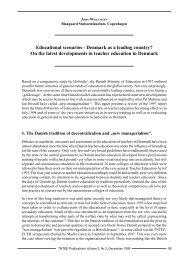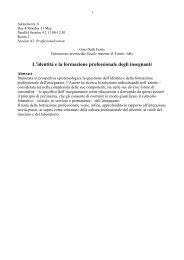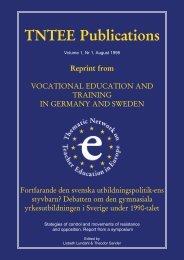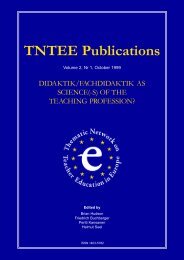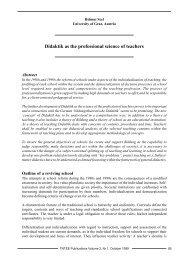Didaktik/Fachdidaktik as Science(-s) of the Teaching ... - tntee
Didaktik/Fachdidaktik as Science(-s) of the Teaching ... - tntee
Didaktik/Fachdidaktik as Science(-s) of the Teaching ... - tntee
- TAGS
- teaching
- tntee
- tntee.umu.se
You also want an ePaper? Increase the reach of your titles
YUMPU automatically turns print PDFs into web optimized ePapers that Google loves.
72<br />
<strong>Didaktik</strong>/fachdidaktik <strong>as</strong> integrative transformation science(-s)<br />
(ii) General systems <strong>the</strong>ory (Luhmann 1984) and a tendency <strong>of</strong> systems towards inner-systemic<br />
differentiations incre<strong>as</strong>ingly neglect <strong>the</strong> systems environment. Reluctance towards substantial<br />
curricular changes may be explained in this way.<br />
(iii) Educational sciences (including educational psychology or educational sociology) and<br />
especially a science <strong>of</strong> teaching, <strong>as</strong> relatively young academic disciplines, could not really<br />
establish <strong>the</strong>mselves in many ITE curricula. 11<br />
(iv) A science <strong>of</strong> <strong>the</strong> teaching pr<strong>of</strong>ession may be seen <strong>as</strong> not very well developed while much<br />
normative (not to say dogmatic) argument and lay technology (not tested on its effects)<br />
seems to dominate, especially <strong>as</strong> regards methodology.<br />
(v) A lack <strong>of</strong> pro-activity <strong>of</strong> institutions and staff <strong>of</strong> ITE who are not always aware <strong>of</strong> both <strong>the</strong><br />
changing context <strong>of</strong> education/TE and <strong>the</strong> state-<strong>of</strong>-<strong>the</strong>-art knowledge produced in relevant<br />
academic fields <strong>of</strong> study.<br />
(vi) Problems with <strong>the</strong> recruitment and <strong>the</strong> career structures <strong>of</strong> staff in institutions <strong>of</strong> ITE. While<br />
decisions to become a teacher are sometimes perceived <strong>as</strong> “second best choices <strong>of</strong> <strong>the</strong> second<br />
best” (cf. Neave 1992), academic careers in TE do not seem to have <strong>the</strong> most prestige in<br />
academic circles.<br />
Similarities to <strong>the</strong> curricula <strong>of</strong> ITE apply to <strong>the</strong> learning cultures adopted in many programs <strong>of</strong> ITE.<br />
Research on teaching and TE h<strong>as</strong> highlighted <strong>the</strong> importance <strong>of</strong> <strong>the</strong> concept <strong>of</strong> “powerful learning<br />
environments” (cf. Buchberger et al. 1994). But, <strong>the</strong> evaluation report on TE in <strong>the</strong> European Union<br />
(Sander et al. 1996) clearly indicates that many programs <strong>of</strong> ITE are by and large oriented on<br />
outdated knowledge transmission models – a “preaching water and drinking wine-phenomenon”?<br />
Similarities apply to problem-, project- and research-oriented learning processes in ITE, which are<br />
missing from many models <strong>of</strong> ITE in <strong>the</strong> European Union (cf. <strong>as</strong> an exception <strong>the</strong> model <strong>of</strong> ITE<br />
adopted in Finland, Buchberger 1995).<br />
As regards <strong>the</strong> practical/clinical component <strong>of</strong> ITE programmes, ra<strong>the</strong>r outdated apprenticeship<br />
models, or models oriented on <strong>the</strong> “practice-relevant experiences”, formula seem to dominate.<br />
Again, knowledge and practices available to provide “powerful learning environments” for<br />
prospective teachers to acquire a flexible repertoire <strong>of</strong> teaching actions is used to a limited extent<br />
only. Although a coherent and supervised teaching practice component provided by specially educated<br />
staff (in co-operative problem-solving groups) may be seen <strong>as</strong> a necessary condition for high quality<br />
ITE (e.g. Brenn et al. 1997), most models <strong>of</strong> ITE do not adopt <strong>the</strong> knowledge b<strong>as</strong>es and scientifically<br />
validated practices available.<br />
A coherent knowledge b<strong>as</strong>e component, an elaborated clinical component and a research component<br />
<strong>as</strong> well <strong>as</strong> <strong>the</strong>ir integration within ITE programmes are still missing. It would be e<strong>as</strong>y to continue<br />
with a long list <strong>of</strong> examples <strong>of</strong> <strong>the</strong> methodological shortcomings <strong>of</strong> ITE. In short, ITE programs do<br />
not make intensive use <strong>of</strong> research-b<strong>as</strong>ed knowledge and scientifically validated practices, and this<br />
fact is closely related to <strong>the</strong> unclear aims and goals <strong>of</strong> ITE (cf. Kennedy 1990), which include<br />
superficial and sometimes irrelevant content, sub-optimal methodologies and inappropriate learning<br />
cultures which are counterproductive to aims declared.<br />
It is worth mentioning that some models and programmes <strong>of</strong> ITE in Member States <strong>of</strong> <strong>the</strong> European<br />
Union may be seen <strong>as</strong> counter-examples to what h<strong>as</strong> been outlined. This is true in many ways <strong>of</strong><br />
ITE at Finnish universities (cf. Buchberger 1995). In addition some promising approaches all over<br />
<strong>the</strong> European Union may bring about an improvement in <strong>the</strong> quality <strong>of</strong> ITE. 12<br />
TNTEE Publications Volume 2, Nr 1, October 1999



